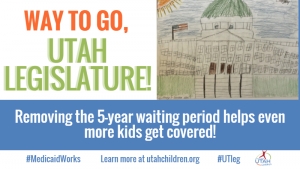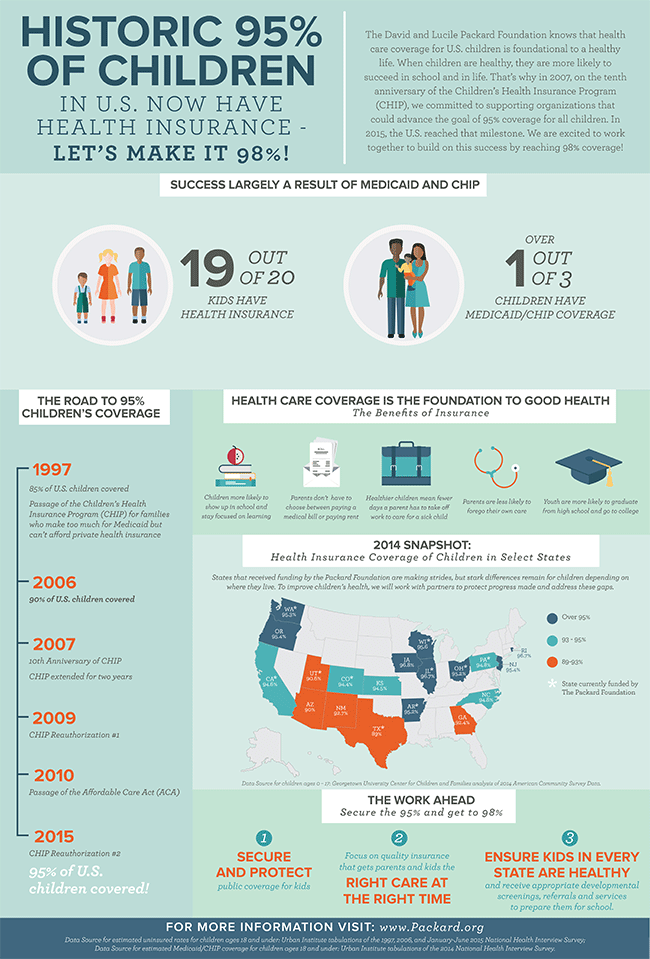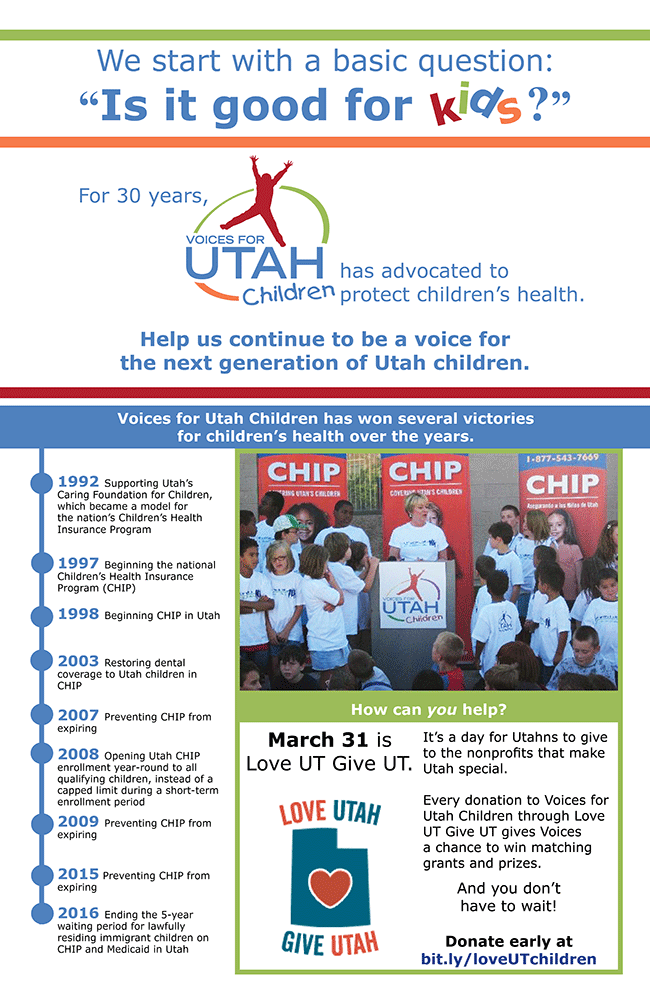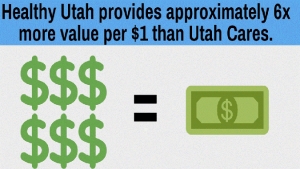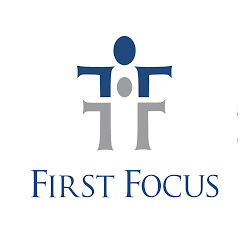Health
The wait is over!
Spread the word: lawfully residing immigrant kids can enroll in CHIP and Medicaid now!
As of July 1st, 2016, new legislation takes effect that eliminates the previously mandated 5-year waiting period before lawfully-residing immigrant children in Utah could enroll in CHIP and Medicaid. Thank you to the Utah Legislature and the Utah Department of Health for making this change! Five years is too long for a child to wait. More good news: the federal government will match up to 100% of the state dollars Utah spends to remove the 5-year waiting period, making this a fiscally-prudent policy change for Utah.
Voices for Utah children supported ending the 5-year wait during the 2016 Utah Legislative Session. Utah has the highest rate of uninsured Hispanic children in the nation and the removal of the 5-year wait is a significant step to help all children in Utah access affordable health coverage.
In addition to allowing states to end the 5-year wait for children, the 2009 Children’s Health Insurance Program Reauthorization Act (CHIPRA) gives states the option to expand insurance coverage to lawfully residing pregnant women. Utah has not yet accepted that option. Going forward, let's end the 5-year wait for pregnant women, too! Prenatal care improves the health of both mothers and their children.
To learn more about CHIP and Medicaid eligibility, call 211 or visit takecareutah.org. (A Spanish version is available at takecareutah.org/es/.)
For 30 years now, Voices for Utah Children has called on our state, federal and local leaders to put children’s needs first. But the work is not done. The children of 30 years ago now have children of their own. Too many of these children are growing up in poverty, without access to healthcare or quality educational opportunities.
How can you be involved?
Make a tax-deductible donation to Voices for Utah Children—or join our Network with a monthly donation of $20 or more. Network membership includes complimentary admission to Network events with food, socializing, and opportunity to meet child advocacy experts. And don't forget to join our listserv to stay informed!
We look forward to the future of Voices for Utah Children and we hope you will be a part of our next 30 years.
Special thanks to American Express for sponsoring our 30th Anniversary Year. 
Racial and Ethnic Equity for Children in Utah
What We Learned from the 2016 Legislative Session
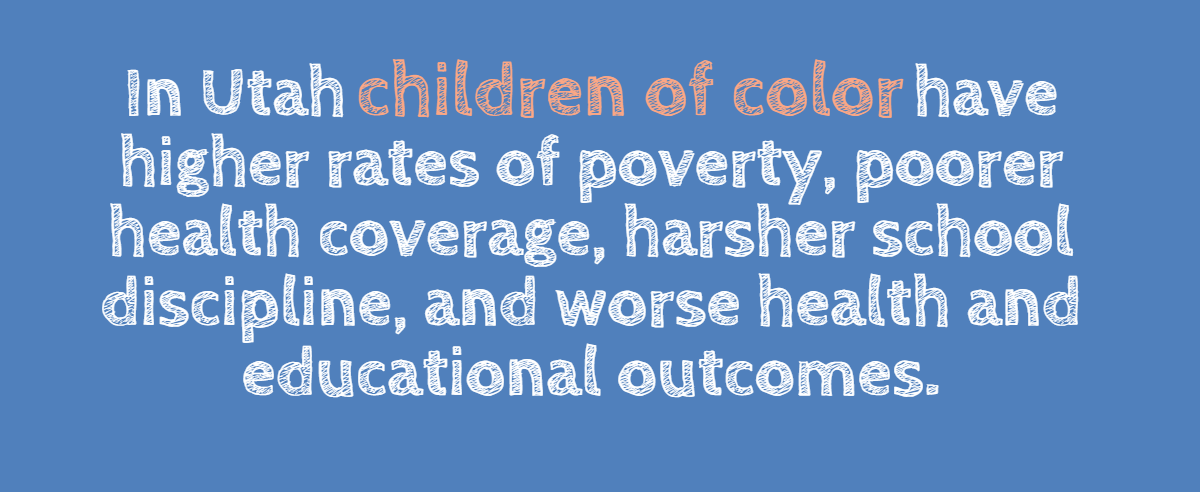
- Children of color in Utah face more poverty compared to non-Hispanic White children. As Utah becomes a more diverse state, children are affected by significant racial and ethnic disparities.
- The 2016 General Session failed to adequately meet the needs of children of color in Utah. There were some important steps forward but also missed opportunities and inaction.
- We saw gains for children’s preschool education, health coverage, school safety and criminal justice. There were missed opportunities to expand kindergarten, address our public defender crisis, expand health coverage for all low-income families and keep more families out of poverty.
- Going forward advocates have a responsibility to integrate an equity lens into our work and build coalitions that will strengthen opportunities for all families.
- Our Legislature, Governor and State Agencies should be more conscious of communities of color and low-income Utahns in their public policy decisions by reviewing the impact of bills and policies on all groups.
- In order to correct growing disparities and invest in Utah’s diverse future, lawmakers need to access data disaggregated by race and ethnicity and work with affected communities when developing policy.
Children’s Racial and Ethnic Equity in Utah
Was the 2016 Legislative Session Good for All Children?
Voices for Utah children starts with one basic question in our advocacy efforts: Is it good for kids?
For over 30 years we have been a statewide advocate, informing policymakers that they can and should act to keep children safe, healthy and help them succeed.
But as Utah’s demographic make-up changes, so too are the questions we have to ask. Is it good for all children, or just some children? Which children are making gains in our state while others are falling behind?
The number of Utah children who are non-White is growing. Since 2000, the percentage of children of color in Utah has grown from 17 to 25%. The Hispanic population is growing even faster. Hispanic children have grown from 11 to 17% of the total child population.
Unfortunately, there is a growing social and economic divide along racial and ethnic lines in Utah. Although Utah is a welcoming state, with a prominent international population, there are disparities among our diverse populations. Families of color face higher poverty rates compared to their White, non-Hispanic counterparts. The median household income for White, non-Hispanic families is significantly higher than all other racial and ethnic groups. White children are two to three times less likely to live in extreme poverty. Endnote 1
As a result, children of color have worse health outcomes, lower educational attainment, and are more likely to face school discipline and be involved in the juvenile justice system. What can we do to reverse this trend and create a Utah where all children can thrive?
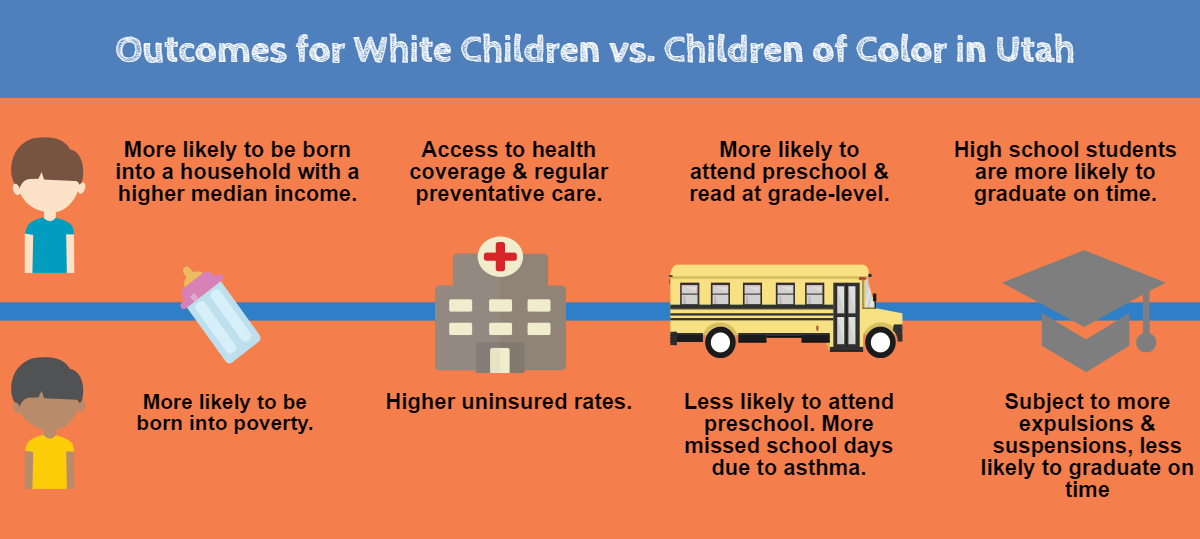
Public policies can help. Public policies play an important role in expanding opportunities for all children, strengthening our schools and public safety net. Endnote 2 But public policies can also create barriers for families. Laws can make it harder for some groups or communities to access care; funding cuts can reduce services. Or simply by maintaining the status quo, policies can perpetuate unnecessary barriers or hidden obstacles for families.
In the recent 2016 Legislative General Session, lawmakers introduced bills that expanded opportunities for children and families and others that created more barriers. At Voices for Utah Children, we look at these laws and ask not only, are they good for children? But also, are they good for everyone, or only some? And under what conditions? Endnote 3
In this report, we will reflect on the 2016 General Session and its potential impact on children from all racial and ethnic backgrounds. We examine legislation in four major issue areas: early childhood education, health, economic equity, and juvenile justice reform. Endnote 4 Using data which is disaggregated by race and ethnicity, this report will consider legislation that expands opportunity for children and youth, as well as missed opportunities for change.
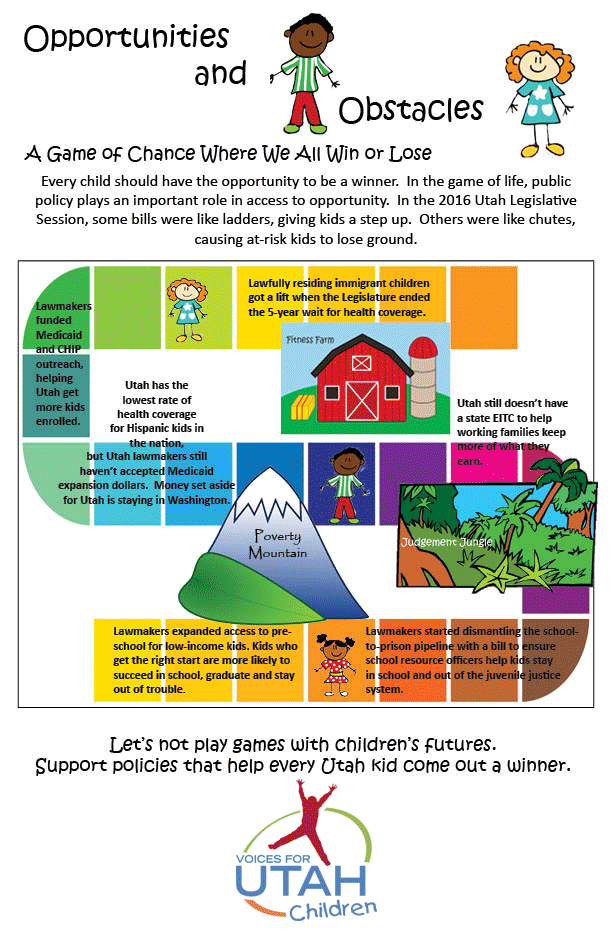
Early Childhood Education
Expanding Opportunities for High-Quality Preschool Programs
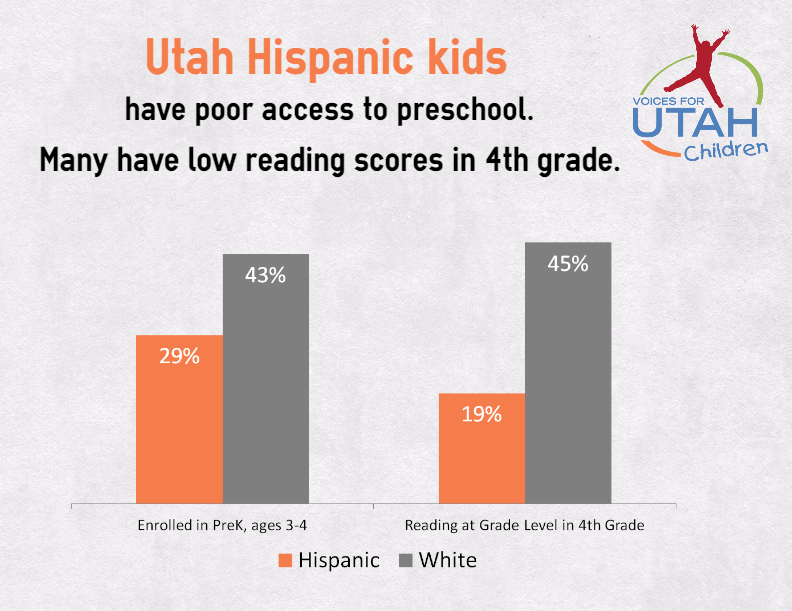
Early education opportunities can reduce racial and ethnic disparities. High-quality preschool helps children gain valuable cognitive, social, emotional and academic skills. Endnote 5 But with an attendance rate of 40%, Utah has one of the lowest rates of preschool attendance and the rate is even lower among children of color. Only 29% of Hispanic children ages 3 - 4 are attending preschool, compared to 43% of White, non-Hispanic children. One factor driving this discrepancy is that there are not enough affordable, quality preschools, especially in high-needs communities.
The Utah Legislature took steps to address this problem through SB 101, which makes more affordable, high-quality preschool slots available. SB 101 creates a grant program to expand high-quality preschool programs for at-risk children. It also provides scholarships for children who have been identified as living in intergenerational poverty. SB 101 was funded through Temporary Assistance for Needy Families (TANF), which directs funds to low-income children. However, the racial and ethnic gap in school readiness may not be fully accounted for by income, as research shows. In the future, Utah needs more programs, and supporting data, which can examine gaps in school readiness between children of different backgrounds, and ways to address those gaps in high-quality preschool programs. Endnote 6
Missed Opportunity: Expanding Optional Extended-Day Kindergarten and Readiness Assessments
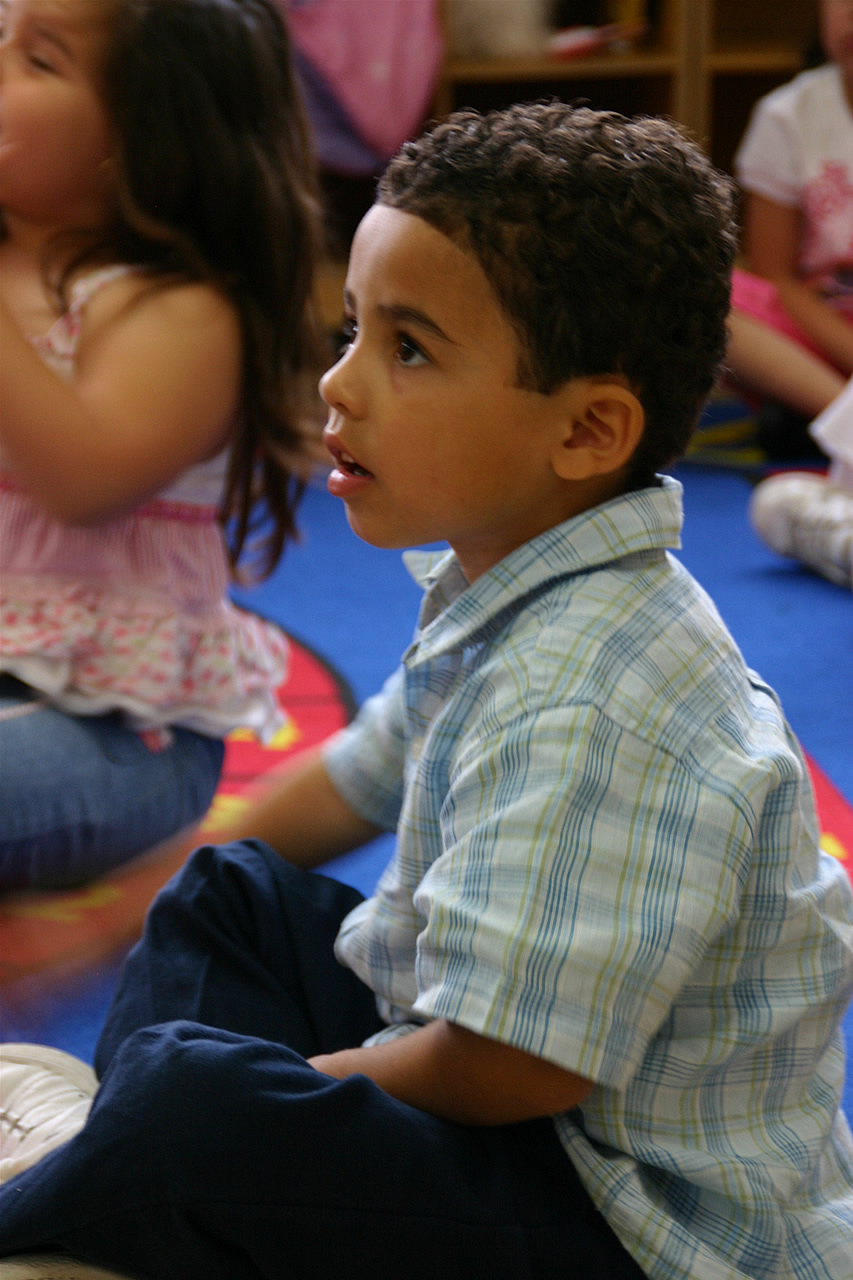 While SB 101 made significant gains for early education, the Legislature missed a critical opportunity to advance continuity in quality programming beyond preschool. HB 42 would have increased funding for quality optional extended-day kindergarten programs and created a statewide kindergarten entry and exit assessment tool.
While SB 101 made significant gains for early education, the Legislature missed a critical opportunity to advance continuity in quality programming beyond preschool. HB 42 would have increased funding for quality optional extended-day kindergarten programs and created a statewide kindergarten entry and exit assessment tool.
Full day kindergarten can help reduce racial and ethnic disparities in academic performance. In Utah, less than 15% of 5-year-olds participate in full day kindergarten programs. Endnote 7 Utah has one of the lowest rates of full day kindergarten participation in the nation. Overall there are not enough high-quality, full day, early education programs available in Utah, especially for at-risk children. This contributes to the achievement gap in later years. For example, 81% of Hispanic children are not reading at a proficient grade level by the 4th grade, compared to 55% of White, non-Hispanic children.
Moreover, Utah also lacks comprehensive data to understand children’s kindergarten readiness. By calling for a statewide entry and exit assessment tool, HB 42 would have allowed schools to better determine children’s kindergarten readiness. A statewide assessment can help educators develop appropriate interventions. Without sound, standardized statewide tools, we cannot adequately assist children most at risk of falling behind. Endnote 8
Juvenile Justice Reform
Expanding Opportunities: School Discipline and Juvenile Sentences
Nationwide, we see troubling racial and ethnic disparities in the juvenile justice system, and Utah is no exception. For example, Black children make up a disproportionate share of the juvenile justice system. Despite being only 1% of the total child population in Utah, Black youth make up 23% of the population in juvenile detention or correctional facilities.
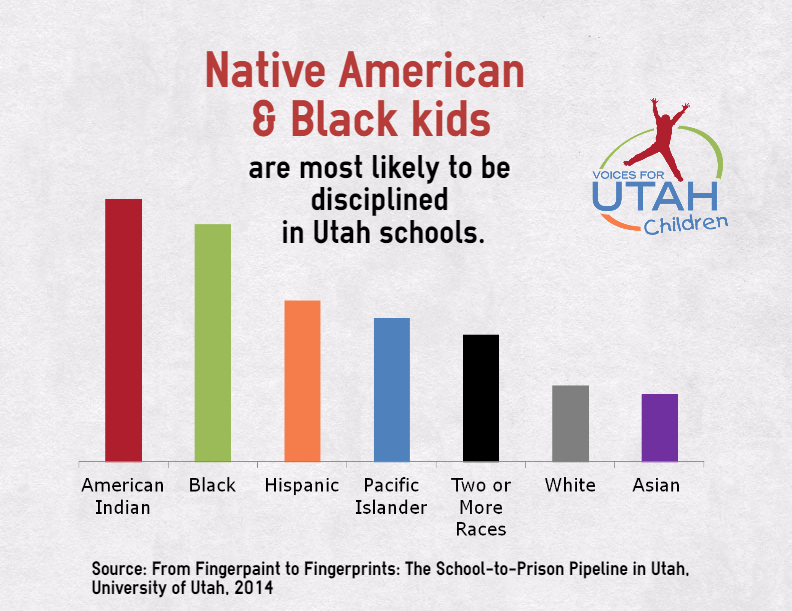
One significant factor leading to youth involvement in the juvenile justice system is school disciplinary action. There is a direct correlation between youth discipline in school and the likelihood that a child will become involved in the criminal justice system. Yet this too disproportionately impacts children along racial and ethnic lines. Children of color consistently face greater school disciplinary action compared to their White, non-Hispanic peers. Endnote 9 For example, American Indian and Black students are more likely to receive disciplinary action in Utah schools than other racial groups.
Given these findings, HB 460 is an encouraging step forward. HB 460 will provide training for school resource officers and school administrators. The law requires that the State Board of Education create a curriculum to help train officers in schools. HB 460 states that the training can include cultural awareness, resources for students exposed to trauma and restorative justice practices. Its aim is to prevent school disciplinary issues from escalating into larger, criminal justice issues. Appropriate training for school resource officers and administrators could reverse existing practices negatively affecting children of color.
Another promising step this legislative session is HB 405, which prohibits children from receiving life sentences without parole. HB 405 represents an important step in ensuring that the criminal justice system recognizes the unique needs of youth and children.
Missed Opportunities to Avoid Harsher Sentencing for Children of Color
There were also some significant missed opportunities for juvenile justice reform. In particular, SB 155 failed to address the crisis of public defenders in Utah. The law proposes to further study the problem and offers small county-level grants for adult indigent defense. While important, however, this will not help youth. All adults and children have the right to counsel if charged with a crime that might lead to jail, but Utah has failed to fulfill this Constitutional requirement. If a child does not have adequate access to a defense attorney, he or she could receive a harsher sentence. Low-income children of color are more likely to find themselves in the criminal justice system, and therefore more likely to experience harsher sentencing. The ‘school to prison pipeline’ in Utah is fueling some of our most alarming racial and ethnic inequities. We need systems committed to addressing these disparities and helping all children succeed.
Economic Equity
Missed Opportunities to Restore Funds for Public Programs
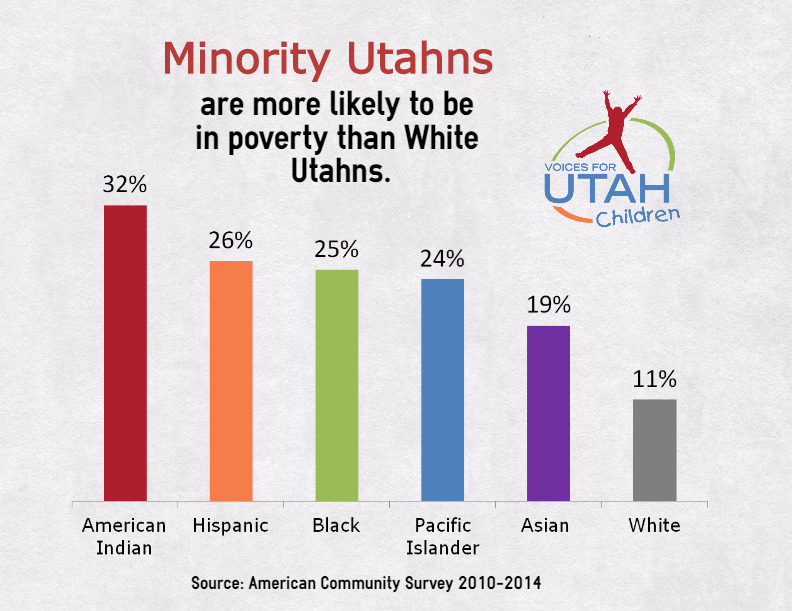
Families of color face higher poverty rates. Although Hispanic children make up only 17% of the total child population, they represent at least 39% of children living in poverty. Among Hispanic children, 31% live below the poverty threshold compared to 8% of non-Hispanic Whites. From the data available by racial and ethnic categories, we know that poverty in Utah is not experienced equally among all racial and ethnic groups.
What can our public policies do to help all Utahns? As a starting point, we need to ensure that there are enough public dollars available in our General Fund for the programs and services proven to help people achieve independence, meet their families’ needs, and move out of poverty. According to the Utah Foundation, public revenues in Utah are at a multi-decade low due to tax cuts enacted over the past decade. The 2016 Legislature failed to pass legislation that would have restored revenues. Instead, the 2016 Legislature focused its attention on several tax cutting measures, passing HB 61 to reduce corporate income taxes by about $3 million annually and coming close to passing HB 180 to expand a business sales tax exemption by $83 million annually.
Even as legislators give serious consideration to tax cuts that reduce funds available for education, health care, and initiatives that help families work their way out of poverty, the practice of earmarking – permanently diverting General Fund revenues to the Transportation Fund to avoid allowing transportation revenue sources like the gas tax to keep up with inflation – continues nearly unabated. Even though the Legislature’s own Tax Review Commission recommended eliminating almost all existing earmarks, the only proposal that passed this year was a compromise bill that restores about 4% of earmarks to the General Fund, while at the same time more deeply entrenching the earmarking phenomenon by redirecting transportation earmarks for water infrastructure instead.
Missed Opportunities to Help Utah Families Work Their Way Out of Poverty
Despite continued advocacy, there was no legislation in the 2016 session for a state-level Earned Income Tax Credit (EITC). The EITC is a policy proven to help millions of U.S. working families stay out of poverty. National data show that the EITC can help mitigate racial and ethnic disparities; almost half of all EITC-eligible households were headed by racial or ethnic minorities. Endnote 10 Families of color are more likely to be eligible for, and greatly benefit from, the EITC. A state-level tax credit for working families in Utah would keep even more families out of poverty.
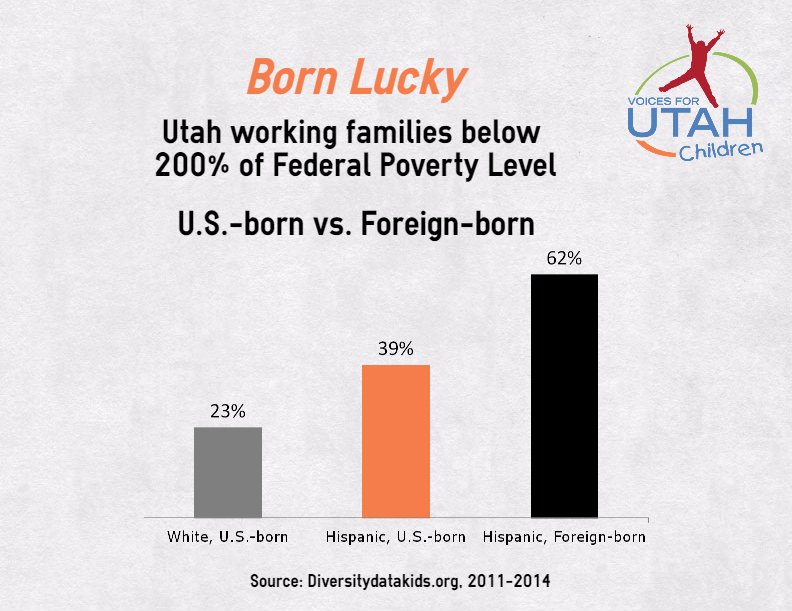 Paid leave was yet another missed opportunity to help families stay out of poverty. Many families do not have access to unpaid leave, and many who do have access are unable to afford it. The 2016 Legislature considered HB 188, which would have provided paid family leave for eligible executive branch agency employees. Families in the executive branch, which includes state divisions, departments and higher education systems, would be able to take leave, without losing pay. The topic will be further studied by the Legislature during the 2016 Interim.
Paid leave was yet another missed opportunity to help families stay out of poverty. Many families do not have access to unpaid leave, and many who do have access are unable to afford it. The 2016 Legislature considered HB 188, which would have provided paid family leave for eligible executive branch agency employees. Families in the executive branch, which includes state divisions, departments and higher education systems, would be able to take leave, without losing pay. The topic will be further studied by the Legislature during the 2016 Interim.
White, non-Hispanic parents in Utah are more likely to be eligible and financially able to take unpaid leave than other families. Discrepancies in family leave policies take the greatest toll on foreign-born parents of color: 20% of Hispanic foreign-born parents are both eligible and can afford unpaid leave, compared to 31% of White foreign-born parents. Among U.S.-born parents, 33% of Hispanic parents and 37% of White parents can afford to take unpaid leave. Endnote 11 Parents who are ineligible or cannot afford leave are at risk of losing pay--or their job-- when they stay home to care for their child.
Health
Expanded Opportunities for Children’s Coverage
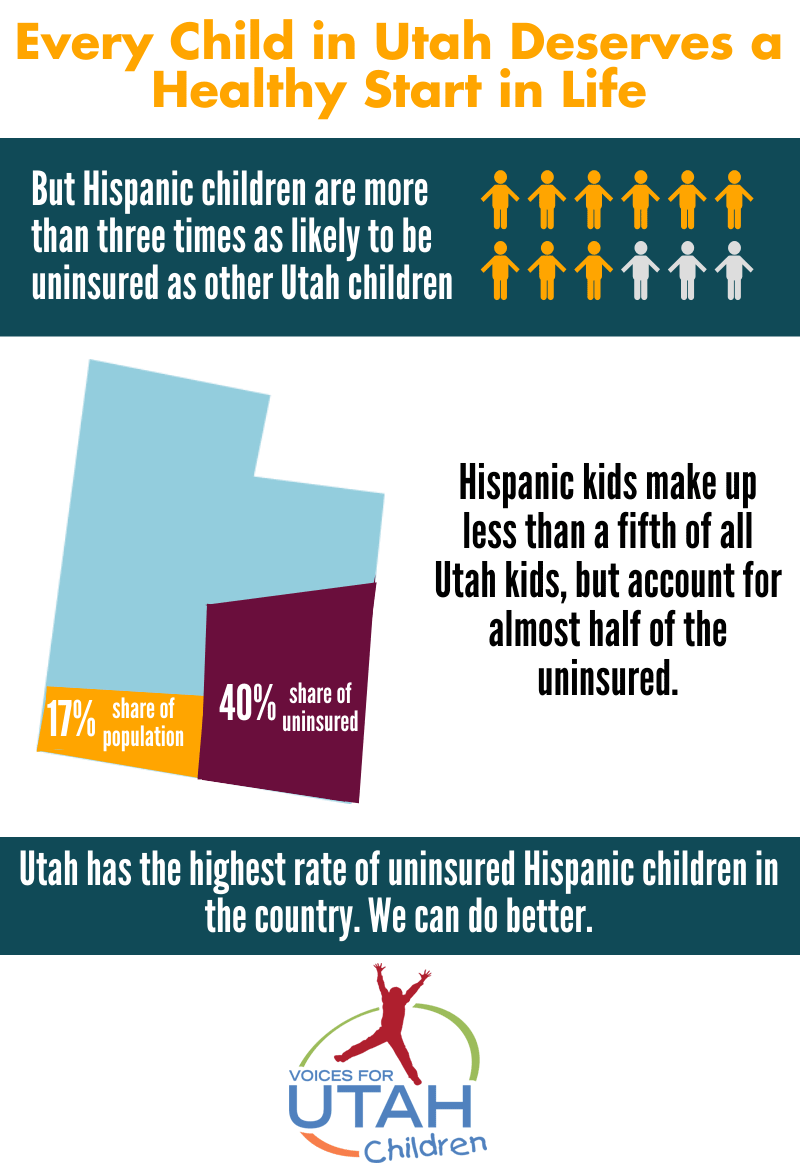
Utah has the highest rate of uninsured Hispanic children in the nation. Utah’s uninsured rate for Hispanic children is nearly two and a half times the national rate; it is higher than the rate in every other state and the District of Columbia. Children’s health coverage is the critical foundation for all children to get the care they need to achieve optimal health.
The 2016 Legislature removed the 5-year waiting period for legal immigrant children to receive CHIP or Medicaid. Appropriations bill HB 2 included intent language directing the Department of Health to enroll children as soon as they qualify. Previously, legal immigrant children were subject to a waiting period before they could receive CHIP or Medicaid. Eligible children include legal permanent residents and some additional immigration categories, although undocumented children are not included. The policy change will mean hundreds of children can get coverage. Five years is too long for children to wait.
In addition, the 2016 Legislature allocated $25,000 in one-time outreach funding to help enroll more children in CHIP or Medicaid. The Department of Health’s outreach budget was eliminated in 2010. The funding, allocated to the Department of Health, will be matched by federal dollars to total $50,000 and can be used to reach more Hispanic children.
The Legislature also directed the Department of Health to examine barriers to children’s coverage, including ‘churn’ or a frequent pattern of disenrollment and then re-enrollment from Medicaid. Children may lose Medicaid coverage because of fluctuations in their family’s income. Hispanic children are more likely to experience churn because of a change in their family’s temporary income status. At least 31% of Hispanic children have parents who lack year-round employment, compared to 18% of White children. The Department of Health’s study on churn could help reduce disruptions in children’s coverage and care.
Missed Opportunities: Expanding Coverage for All Parents
The 2016 Utah Legislature took first steps to cover more Utahns caught in the insurance coverage gap. HB 437 changed Medicaid eligibility to cover an estimated 4,000 additional parents, effectively raising the eligibility ceiling for parents with children up to 60% of the Federal Poverty Level. Unfortunately, the Legislature rejected more comprehensive bills that would fully close the coverage gap. As a result, thousands of working parents are still left without health insurance. Over one-quarter of the parents who would benefit from a full Medicaid expansion plan are Hispanic. When parents have insurance they are better able to care for their children. In addition, when parents have coverage, they bring their children along; enrollment numbers for children go up when parents have health coverage. Coverage for parents helps the whole family.
Recommendations Going Forward
Different communities may need different resources
to achieve similar outcomes.
The 2016 Legislative Session expanded opportunities for some children, but there were also many missed opportunities to improve the lives of children from all racial and ethnic backgrounds. These initial steps, while important, still leave much work ahead. Endnote 12
Across every issue area reviewed, we found significant social, economic, and health disparities affecting children of color. Utah laws and policies do not adequately address the growing diversity of our state. The face of Utah’s most vulnerable is changing. We need laws that embrace our diverse future.
This report is both a reflection of our own advocacy practices, as well as a call to action for lawmakers.
As advocates, we have a responsibility to integrate a lens of racial and ethnic equity into our own work and build coalitions that will strengthen opportunities for all families.
Together with community partners, we hope to contribute to a growing dialogue about racial and ethnic equity in the coming year and to advance policies that can help reduce disparities.
Our lawmakers also have a responsibility to create a more equitable Utah. To secure a future that is safe and healthy for all children, we call on our Legislature, Governor and State Agencies to:
- Work with coalitions and affected communities.
Ensure that those most affected are actively involved in developing policies. To create sustainable solutions, families from all communities must be consulted, engaged and able to meaningfully participate in the policy process. - Collect, disaggregate and disseminate data by race and ethnicity.
Our policymakers need access to the best data and analyses. Too often population measures of children’s well-being are not disaggregated by race or ethnicity. Several state-level initiatives have already begun to make progress in this area. We need to expand these efforts so we can track progress and find solutions. Without disaggregated data, we have an incomplete picture of the needs and outcomes affecting all Utah children. - Review the racial and ethnic impact of public policies.
Our lawmakers and policymakers should review the impact of proposed policies on different racial and ethnic groups. Racial and ethnic impact assessment tools can highlight which groups benefit, and under what conditions. These targeted measures can correct disparities and help our legislators make informed decisions for all communities in Utah.
Printer-friendly version:
![]() Racial and Ethnic Equity for Children in Utah: What We Learned from the 2016 Legislative Session
Racial and Ethnic Equity for Children in Utah: What We Learned from the 2016 Legislative Session
1. Unless otherwise noted, data and indicators are from the national Kids Count Data Center: http://datacenter.kidscount.org/data#UT/2/0/char/0
2. Arkansas Advocates for Children and Families. (2015) “Missing the Mark: Race Equity and Missed Opportunity in the 2015 Session. Research Brief July 2015. Available at: http://www.aradvocates.org/publications/missing-the-mark-race-equity-and-missed-opportunities-in-the-2015-session/
3. DiversityDataKids.org. “What is Research Evidence and Why Does It Matter for Equity?” The Heller School for Social Policy and Management at Brandeis University. Available at: http://www.diversitydatakids.org/files/Policy/Head%20Start/Research%20Evidence/What%20is%20Research%20Evidence.pdf
4. Voices for Utah Children focused on these major issue areas during the 2016 Legislative Session. This report does not represent a comprehensive review of all legislation.
5. Heckman, J. J. (2011) "The American Family in Black & White: A Post-Racial Strategy for Improving Skills to Promote Equality." Daedalus, 140(2), 70-89.
6. Magnuson, K. A., & Duncan, G. J. (2005) "Can Family Socioeconomic Resources Account for Racial and Ethnic Test Score Gaps?" The future of children, 15(1), 35-54.
7. Utah Foundation. (2015) “Lessons From Our Neighbor: Learning From Colorado’s Educational Success.” Research Report 731, July 2015. Available at: http://www.utahfoundation.org/uploads/rr731.pdf
8. Utah Department of Workforce Services. (2015) “Fourth Annual Report on Intergenerational Poverty, Welfare Dependency and the Use of Public Assistance.” Utah Intergenerational Welfare Reform Commission Annual Report. Available at: https://jobs.utah.gov/edo/intergenerational/igp15.pdf
9. University of Utah S. J. Quinney College of Law. (2014) “From Fingerpaints to Fingerprints: The School-to-Prison Pipeline in Utah.” Public Policy Clinic Report. Available at: https://www.law.utah.edu/news/from-fingerpaint-to-fingerprints-the-school-to-prison-pipeline-in-utah/
10. Holt, Steve. (2006) “The Earned Income Tax Credit at 30: What We Know.” Research Brief February 2006. Washington DC: The Brookings Institution Metropolitan Policy Program. Available at: http://www.brookings.edu/research/reports/2006/02/childrenfamilies-holt
11. DiversityDataKids.org. (2014) “Working Parents Who Are Eligible For and Can Afford FMLA Unpaid Leave.” Utah Map. Available at: http://www.diversitydatakids.org/data/map/510/working-parents-who-are-eligible-for-and-can-afford-fmla-unpaid-leave-share/#loct=2&cat=28,24&tf=17
12. The following were references and models for this report: Arkansas Advocates for Children and Families. “Missing the Mark: Race Equity and Missed Opportunity in the 2015 Session.” Available at: http://www.aradvocates.org/publications/missing-the-mark-race-equity-and-missed-opportunities-in-the-2015-session/; “Facing Race: The 2015 Oregon Racial Equity Legislative Report.” Available at: https://facingraceoregondotorg.files.wordpress.com/2016/01/2015facingraceweb.pdf; “Strong Families New Mexico 2015 Legislative Report Card.” Available at: http://strongfamiliesmovement.org/nm-reportcard
For 30 years now, Voices for Utah Children has called on our state, federal and local leaders to put children’s needs first. But the work is not done. The children of 30 years ago now have children of their own. Too many of these children are growing up in poverty, without access to healthcare or quality educational opportunities.
How can you be involved?
Make a tax-deductible donation to Voices for Utah Children—or join our Network with a monthly donation of $20 or more. Network membership includes complimentary admission to Network events with food, socializing, and opportunity to meet child advocacy experts. And don't forget to join our listserv to stay informed!
We look forward to the future of Voices for Utah Children and we hope you will be a part of our next 30 years.
Special thanks to American Express for sponsoring our 30th Anniversary Year. 
U.S.A. reaches goal of 95% health insurance coverage for children but Utah lags behind
In 2007, on the 10th anniversary of the Children’s Health Insurance Program (CHIP), the David and Lucile Packard Foundation and its partners committed to helping ensure that 95% of the nation’s children ages 0 to 18 had health insurance. This year the nation reached this historic goal, according to the Urban Institute’s report: Uninsurance among Children, 1997–2015 : Long-Term Trends and Recent Patterns. The success of CHIP and the expansion of Medicaid in many states were critical for reaching these historic numbers for health insurance coverage.
However, Utah lags the nation, with only 90.6% of Utah children insured. In fact, Utah ranks among the bottom of all states for children’s health insurance coverage and Utah Hispanic children are particularly unlikely to have health insurance. Nationwide, 9.7% of Hispanic children are uninsured but 23.4% of Utah Hispanic children are uninsured.
Children with access to quality, comprehensive health coverage are more likely to attend school and stay focused on learning. Healthier children means parents take fewer days off work to care for a sick child. It also means parents don’t have to choose between paying a medical bill or paying rent.
How can we get more Utah kids covered?
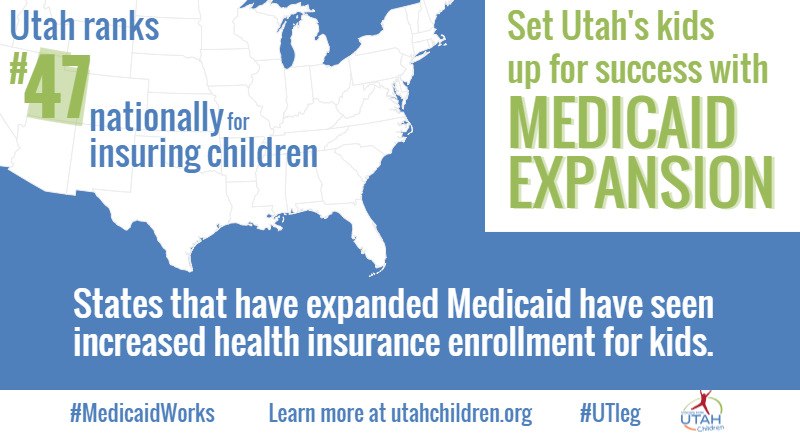 Follow through with the work begun at the 2016 Legislature. During the recent session, Utah lawmakers added intent language to end the 5-year wait for lawfully residing immigrant children, agreed to study options to improve enrollment in Medicaid, and allocated funding to Medicaid and CHIP outreach for the first time in years. Let’s finish what we started.
Follow through with the work begun at the 2016 Legislature. During the recent session, Utah lawmakers added intent language to end the 5-year wait for lawfully residing immigrant children, agreed to study options to improve enrollment in Medicaid, and allocated funding to Medicaid and CHIP outreach for the first time in years. Let’s finish what we started.- Cover the gap. States that fully expanded Medicaid saw more improvement in children’s health insurance coverage than states like Utah. Utah lawmakers chose to leave money on the table in Washington rather than fully cover the gap. Expanding Medicaid would help Utah address Utah’s low enrollment of eligible children in Medicaid and CHIP, as newly eligible adults enroll their whole families.
- Extend CHIP. CHIP funding is scheduled to end in 2017 despite its overwhelming success.
Now that the goal of getting 95% of children insured has been met nationally, the Packard Foundation has announced a new commitment to reach 98% coverage for our nation’s children. By the time the nation meets this new goal, we hope to be able to say that Utah kids are just as likely to be insured as children across the nation. Let’s catch up now.
For 30 years now, Voices for Utah Children has called on our state, federal and local leaders to put children’s needs first. But the work is not done. The children of 30 years ago now have children of their own. Too many of these children are growing up in poverty, without access to healthcare or quality educational opportunities.
How can you be involved?
Make a tax-deductible donation to Voices for Utah Children—or join our Network with a monthly donation of $20 or more. Network membership includes complimentary admission to Network events with food, socializing, and opportunity to meet child advocacy experts. And don't forget to join our listserv to stay informed!
We look forward to the future of Voices for Utah Children and we hope you will be a part of our next 30 years.
Special thanks to American Express for sponsoring our 30th Anniversary Year. 
Last year, we brought you a version of The Good, The Bad and The Ugly for our legislative overview. For this year’s health policy round-up, we’re relying on another classic Western, The Magnificent Seven, to review the seven main children’s health issues of the session. Not all seven topics made it to the end of the session (much like the gunslingers in the movie). But all of them put up a good fight.
1. Enrolling More Children in CHIP and Medicaid
Utah has one of the highest rates of uninsured children in the nation. We need to take the steps to help children and families enroll–and stay enrolled–in health coverage. There are 85,000 uninsured children in Utah. Even more concerning, the majority of uninsured children in the state are already eligible for health insurance coverage like CHIP or Medicaid but not enrolled.
Fortunately, some important steps were taken this session. The legislature allocated state funding to the Department of Health for CHIP and Medicaid outreach so that more families can learn about their coverage options. In addition, the legislature directed the Department of Health to study some of the barriers to children’s enrollment in CHIP and Medicaid and the fixes needed so more children have coverage. Some of the potential fixes include 12-month continuous eligibility for children on Medicaid, which would allow children to maintain coverage for one full year, even if families experience a change in income or family status. Finally, the legislature removed the five-year waiting period for legal immigrant children to receive CHIP and Medicaid. Immigrant children who would otherwise qualify for CHIP and Medicaid no longer have to wait five years to receive health coverage.
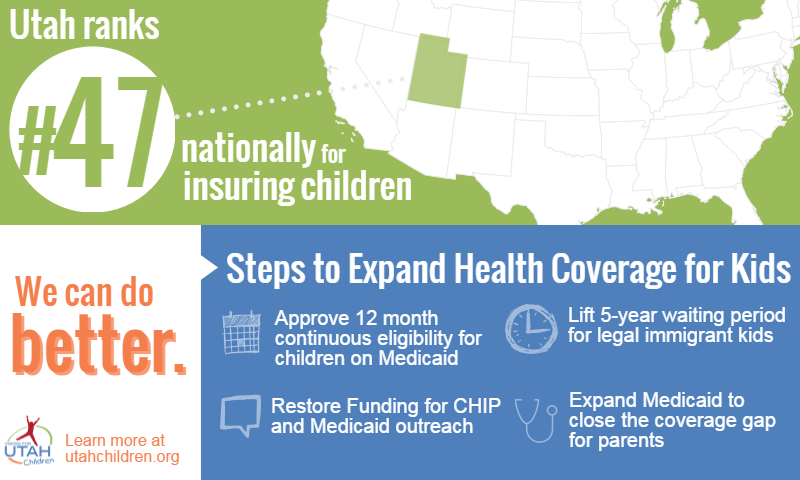
2. Health Coverage for Parents
Healthy parents = healthy children. When parents have insurance, they are better able to care for their children. In addition, when parents have coverage they bring their children along too. Enrollment numbers for children go up when parents have health coverage. Unfortunately there are tens of thousands of uninsured parents in Utah today. While the legislature did not close the coverage gap this session, it took important first steps. HB 437 (Rep Dunnigan R-Taylorsville) changed Medicaid eligibility to cover an estimated 3,800 additional parents, effectively raising the eligibility ceiling for parents with children up to 60% of Federal Poverty Level. More robust bills that did not become law, including SB 77 (Sen Gene Davis D-Salt Lake County), would have expanded Medicaid and closed the coverage gap. In addition, the legislature funded Primary Care Access Grants. These grants help many low-income families and individuals, especially in rural areas. These are important steps to take, but we need to continue on until all Utahns have access to comprehensive health coverage.
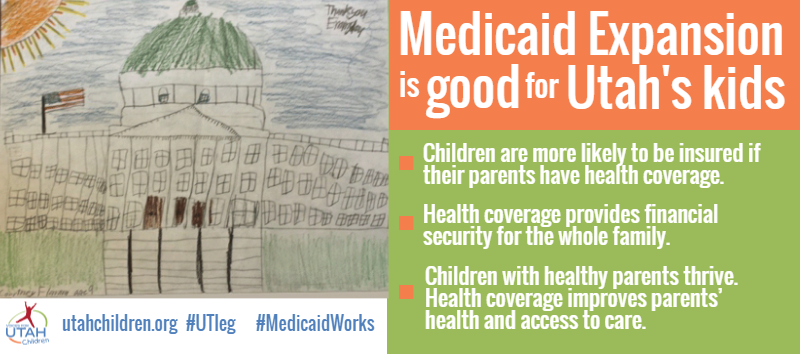
3. Reducing Health Disparities
Children of color are more likely to experience poor health outcomes compared to White children. Utah has the highest rate of uninsured Hispanic children in the nation. Hispanic children make up 17% of the population, but they make up 40% of the total uninsured population. As mentioned above, one win for the session was the elimination of the five-year waiting period for legal immigrant children. Legal permanent resident (LPR) children will soon be able to enroll in CHIP or Medicaid as soon as they qualify, without having to wait five years. At the request of the Governor’s budget, the legislature also allocated funding for Family Spirit, a home visiting program specifically for young Native American families in Utah. The program is a culturally-focused and strength-based approach for new parents and their children. These measures move our state in the right direction; but more work is needed. All children, regardless of their racial or ethnic background, should be able to access the care they need to achieve optimal health.
4. Disease Prevention and Health Promotion
The following public health policies were not enacted, although they would have saved the state money and improved children’s health:
Curtailing Youth Tobacco Use: HB 157 (Representative Kraig Powell R-Heber City) would have raised the age limit for tobacco use and HB 333 (Representative Paul Ray R-Clearfield) imposed an e-cigarette tax. These are important steps to prevent rising rates of e-cigarette use among youth in our state. Despite strong support, including active youth advocacy, both of these bills failed in committee.
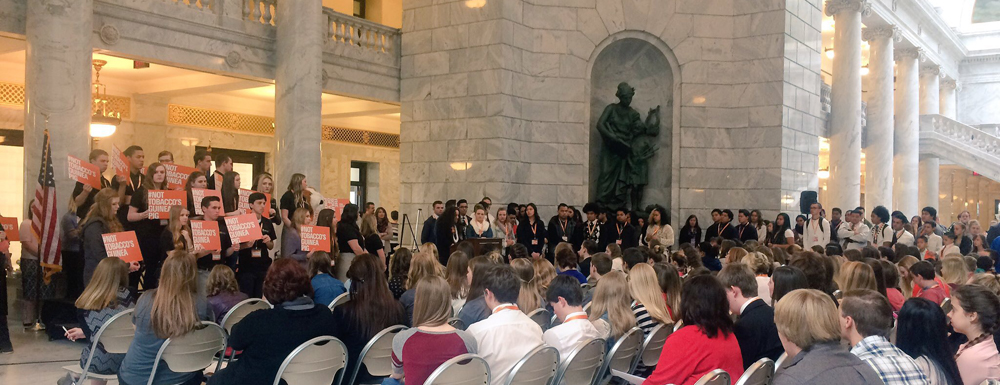
Information about Childhood Immunizations: Choosing not to vaccinate your child is a serious decision for one’s child and community. HB 221 (Rep Carol Spackman-Moss D-Salt Lake City) would have required parents who choose not to vaccinate to take a brief online training. The training would inform parents how to recognize the signs and symptoms of disease and learn what to do in the event of a disease outbreak in order to keep their child safe. The bill narrowly passed the House. However in the final days of the session, the Senate made amendments to the bill that undermined its intent. There was not adequate time to resolve these differences and the bill did not pass. As immunization rates in Utah decline, more children are at risk when disease outbreaks occur. This bill highlights the need for continued public health awareness, information and discussion so that all children in Utah can be safe.
Family planning: Representative King sponsored HB 246, Reproductive Health Amendments, that would have provided comprehensive sex education in schools. It also would have allowed more low-income families to receive comprehensive family planning services. This bill would have helped reduce rising rates of sexually transmitted infections by helping more teens make informed choices. However, controversies surrounding sex education kept this bill from advancing out of committee.
5. Services for Children with Special Healthcare Needs
Legislators increased some of the funding for children with special needs. The Baby Watch Early Intervention program received one-time funding to support its critical programs. Legislators including Sen. Luz Escamilla (D-Salt Lake City) and advocates worked tirelessly to make sure the programming could continue. As parents can testify, the Baby Watch Early Intervention program allows parents to receive the early support, assessment and coordination of care they need for their children. The legislature also funded additional slots and increased the caseload for the Medically Complex Children’s Waiver in the Medicaid Program. Additionally, in HB 2, the legislature also allocated funding for the children’s hearing aid pilot program account. In the future, more funds are needed for children with special health care needs, but the legislature took important measures to help more children and families.
6. Crisis Nurseries and Home Visiting for Under-Resourced Families
The Utah legislature allocated funding for families in crisis in HB 2. These funds include TANF funding for domestic violence shelters. It also includes some funding for crisis/respite nurseries under contract with the Division of Child and Family Services. Crisis nurseries play a vital role for families experiencing hardship. In addition, the legislature allocated funding to home visiting programs. The two evidence-based programs funded are Family Spirit and Parents as Teachers. Home visiting programs have been shown to improve the long and short term health outcome for new mothers and their children.
7. Maternal Health and Prenatal Services
The legislature considered several bills that address obstetric care for moms, including two bills that addressed midwifery services. HB 184 (Rep Spackman Moss) made technical changes to current midwifery practices. SB 108 (Sen Deirdre Henderson) removed certain restrictions on licensed birth centers to enable expanded services, despite some concerns from the despite some concerns from physician groups. Both HB 184 and SB 108 passed.
HB 246, Reproductive Health Amendments, also included a provision that would expand family planning services for low-income families that do not qualify for Medicaid. Since this bill failed in committee, it was a missed opportunity for the state to apply for a waiver to extend family planning services for women at 138% of Federal Poverty Level. The state would have received an enhanced federal matching rate for such services, making this a cost-effective policy change for the state. In addition, the provision would have helped individuals who fall in the coverage gap receive comprehensive family planning services.
Those are some of the “magnificent” seven health topics from the 2016 legislative session. For more information on any of the issues or bills mentioned, please contact Jessie Mandle. Voices for Utah Children will continue the fight this coming year so that all children in our state can achieve health and wellness.
 March 31, 2016 is Love UT Give UT!
March 31, 2016 is Love UT Give UT!
It’s a day for Utahns to give to the nonprofits that make Utah special. Every donation to Voices for Utah Children through Love UT Give UT gives Voices a chance to win matching grants and prizes.
And you don't have to wait! Donate now at http://bit.ly/loveUTchildren.
For 30 years now, Voices for Utah Children has called on our state, federal and local leaders to put children’s needs first. But the work is not done. The children of 30 years ago now have children of their own. Too many of these children are growing up in poverty, without access to healthcare or quality educational opportunities.
How can you be involved?
Make a tax-deductible donation to Voices for Utah Children—or join our Network with a monthly donation of $20 or more. Network membership includes complimentary admission to Network events with food, socializing, and opportunity to meet child advocacy experts. And don't forget to join our listserv to stay informed!
We look forward to the future of Voices for Utah Children and we hope you will be a part of our next 30 years.
Special thanks to American Express for sponsoring our 30th Anniversary Year. 
Help us keep protecting children's health with #loveUTgiveUT
 March 31, 2016 is Love UT Give UT!
March 31, 2016 is Love UT Give UT!
It’s a day for Utahns to give to the nonprofits that make Utah special. Every donation to Voices for Utah Children through Love UT Give UT gives Voices a chance to win matching grants and prizes.
And you don't have to wait! Donate now at http://bit.ly/loveUTchildren.
For 30 years now, Voices for Utah Children has called on our state, federal and local leaders to put children’s needs first. But the work is not done. The children of 30 years ago now have children of their own. Too many of these children are growing up in poverty, without access to healthcare or quality educational opportunities.
How can you be involved?
Make a tax-deductible donation to Voices for Utah Children—or join our Network with a monthly donation of $20 or more. Network membership includes complimentary admission to Network events with food, socializing, and opportunity to meet child advocacy experts. And don't forget to join our listserv to stay informed!
We look forward to the future of Voices for Utah Children and we hope you will be a part of our next 30 years.
Special thanks to American Express for sponsoring our 30th Anniversary Year. 
A Tale of Two Utahs: How do Urban and Rural Utah Measure Up?
 It is widely agreed that rural communities have a different set of issues than more urban communities. While all low-income families, regardless of where they live, need connections to support programs and access to economic opportunities, strategies that work in urban areas often cannot be applied to rural areas where social and economic programs are few and far between.
It is widely agreed that rural communities have a different set of issues than more urban communities. While all low-income families, regardless of where they live, need connections to support programs and access to economic opportunities, strategies that work in urban areas often cannot be applied to rural areas where social and economic programs are few and far between.
Because access to services is such an important issue in Utah’s rural areas, it is imperative that policymakers and service providers have a clear view of the problems facing rural communities. In Voices for Utah Children’s annual publication Measures of Child Well-Being in Utah, a variety of child well-being indicators are presented at the county level. These indicators cover important milestones in areas such as economic security, education, and health.
This edition of Data Links explores several of the indicators annually presented in Measures to see how much or if child well-being differs in rural communities as compared to urban communities.
DEFINING URBAN AND RURAL
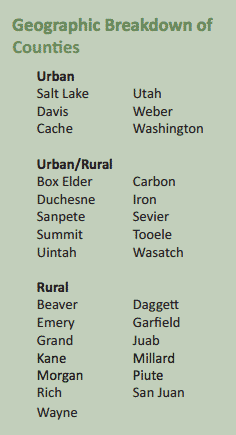 There are a myriad of definitions for “urban” and “rural” from a variety of sources. For the purposes of this report we have chosen to use three categories based on the American Community Survey’s three breakdowns for the one year, three year and five year estimates:
There are a myriad of definitions for “urban” and “rural” from a variety of sources. For the purposes of this report we have chosen to use three categories based on the American Community Survey’s three breakdowns for the one year, three year and five year estimates:
Urban Areas - Areas with populations of 65,000+
Urban/Rural - Areas with populations of 64,999 to 20,000
Rural Areas - Areas of population 20,000 and under
Counties included in each area are indicated in the box to the right.
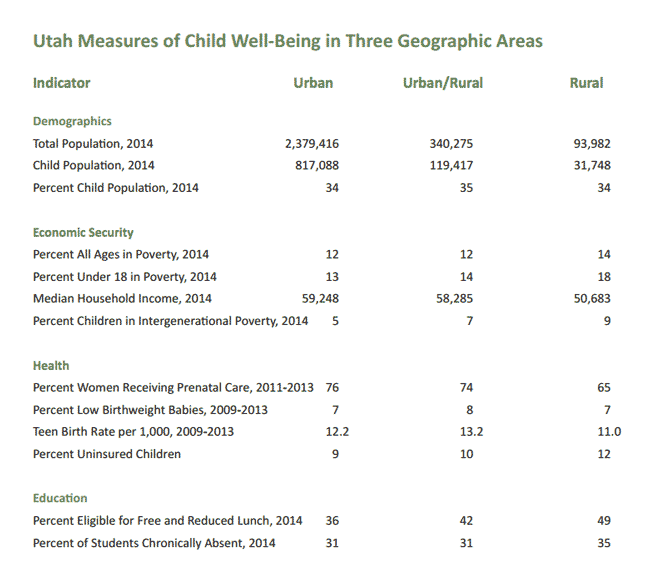

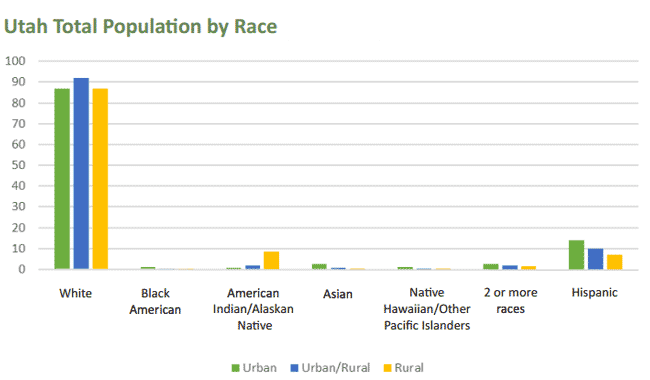
CONCLUSION
This data brief started out by saying it is widely agreed that rural communities have a different set of issues than urban communities. Access to services is difficult for a variety of reasons including lack of transportation and a lack of service providers. When there are no providers in town and individuals must wait on availability, scheduling can become a problem. In some cases where an individual has no family leave policy, traveling to a provider can mean missed wages. Child well-being indicators for children in rural Utah are, in general, slightly worse than those in urban areas. This makes all the above issues even more pressing and an area of concern that needs to be addressed.
“In urban areas, questions of access to care often revolve around whether all segments of the population have access to the full range of specialized medical centers serving the metropolitan area. In rural areas, the issue is often whether there are any health care facilities and providers to access at all. Large metropolitan counties have nearly four times as many physicians per 100,000 residents as do rural counties with only small towns."
Demographic Trends in Rural and Small Town America KENNETH JOHNSON, Carsey Institute Reports on Rural America 01/2006
Printer-friendly report:
![]() A Tale of Two Utahs: How do Urban and Rural Utah Measure Up?
A Tale of Two Utahs: How do Urban and Rural Utah Measure Up?
(Sources and definitions are available in the printer-friendly version of this report.)
 March 31, 2016 is Love UT Give UT!
March 31, 2016 is Love UT Give UT!
It’s a day for Utahns to give to the nonprofits that make Utah special. Every donation to Voices for Utah Children through Love UT Give UT gives Voices a chance to win matching grants and prizes.
And you don't have to wait! Donate now at http://bit.ly/loveUTchildren.
For 30 years now, Voices for Utah Children has called on our state, federal and local leaders to put children’s needs first. But the work is not done. The children of 30 years ago now have children of their own. Too many of these children are growing up in poverty, without access to healthcare or quality educational opportunities.
How can you be involved?
Make a tax-deductible donation to Voices for Utah Children—or join our Network with a monthly donation of $20 or more. Network membership includes complimentary admission to Network events with food, socializing, and opportunity to meet child advocacy experts. And don't forget to join our listserv to stay informed!
We look forward to the future of Voices for Utah Children and we hope you will be a part of our next 30 years.
Special thanks to American Express for sponsoring our 30th Anniversary Year. 
2016 Utah Legislative Session
The 2016 Utah Legislative Session is underway January 25-March 10. Learn more about issues affecting children that will be addressed during this session:
Tax and Budget Issues
Creating a State Earned Income Tax Credit (EITC)
Health Issues
Restore Funds for CHIP and Medicaid Outreach
12-month Continuous Eligibility
Education Issues
Optional Extended Day Kindergarten
Bills
News Contact Lawmakers Sign Up for E-Alerts
For 30 years now, Voices for Utah Children has called on our state, federal and local leaders to put children’s needs first. But the work is not done. The children of 30 years ago now have children of their own. Too many of these children are growing up in poverty, without access to healthcare or quality educational opportunities.
How can you be involved?
Make a tax-deductible donation to Voices for Utah Children—or join our Network with a monthly donation of $20 or more. Network membership includes complimentary admission to Network events with food, socializing, and opportunity to meet child advocacy experts. And don't forget to join our listserv to stay informed!
We look forward to the future of Voices for Utah Children and we hope you will be a part of our next 30 years.
Special thanks to American Express for sponsoring our 30th Anniversary Year. 
The 2015 Children's Budget Report: Adding Up Our Commitment to Kids
Why a “Children’s Budget”?
Children, it is often said, are Utah’s most precious resource. They represent the workforce, consumers, and leaders of tomorrow. For that reason, the investments we make in our children today have enormous economic and social implications for Utah’s future. That is why our federal, state, and local units of government pool taxpayers’ resources to establish an education system, provide for the health and other basic needs of our most vulnerable children, and intervene in children’s lives when their safety is at risk.
This report, Children’s Budget 2015, examines public investment in children from FY2008 through FY2014. It is an update of earlier reports by Voices for Utah Children published in 2009 and 2011. This report does not assess the effectiveness of these programs or gaps in services. Rather, it objectively quantifies the level of public funding for children in Utah and identifies trends over the seven-year period.
There is a strong case to be made that no one cares more about kids than Utahns. Utah has the highest fertility rate in the country and the most children as a percentage of its population, 31% vs. 24% for the nation . Utah saw the second fastest growth rate in its child population of any state from 2000 to 2010 , second only to Nevada (which grows mostly by in-migration rather than through births). Given the high priority Utahns place on children, understanding how much is spent on children by the state and for what purposes is critically important for policymakers and the general public.
Information on funding for children is important for several reasons. It can:
1. Assist policymakers in assessing whether their funding decisions reflect, in the aggregate, their priorities with respect to children.
2. Illustrate how specific programs compare with spending on children overall.
3. Aid policymakers in examining how much is spent on children for specific purposes (i.e. for early education or child welfare) or how funding for children compares to total state and federal spending in the state.
Examining how much Utah invests in children can help the state evaluate how efficiently it is enhancing the potential of our future workforce and maximizing our investment in human capital and economic development. Public investment in children in Utah should be understood as an important component of our economic development strategy that impacts the state as a whole, both in the present and the future.
In this report, Voices for Utah Children divides all state programs concerning children into seven categories, without regard to their location within the structure of state government. The seven categories are as follows, in descending order by dollar value (based on the sums of both state and federal funds):
• Education, which makes up 90% of the state-funded portion of the Children’s Budget and 77% overall counting both state and federal funds
• Health
• Food and Nutrition
• Early Childhood Education
• Child Welfare
• Juvenile Justice
• Income Support
We then add up the expenditures in each of these areas, separating state from federal dollars, and we compare the figures over time from FY2008, the last year before the state budget began to be affected by the Great Recession, through FY2014, the most recent year for which final expenditure data was available.
Our most important finding is the following:
While the state economy has recovered from the Great Recession in a number of respects, state investment in children has not. Specifically, real (inflation-adjusted) state investment in children in FY2014 remained 6% below what it had been in FY2008, at $5,424 per child in FY2014, compared to $5,746 in FY2008.
Making up that $322 per-child gap between the FY2008 level of public investment in children and the level in FY2014 would have required an additional state expenditure in FY2014 of approximately $293 million.
This finding that state government investment in children has not yet recovered from the recession is not the only example of how Utah still remains below its pre-recession performance, even five years after the recession ended. For example, real median wages also remain below pre-recession levels and poverty rates have remained elevated well above where they were at the same point in previous economic expansions.
For more information, see the complete report:
Utah Children's Budget Report 2015
For 30 years now, Voices for Utah Children has called on our state, federal and local leaders to put children’s needs first. But the work is not done. The children of 30 years ago now have children of their own. Too many of these children are growing up in poverty, without access to healthcare or quality educational opportunities. How can you be involved?
- Celebrate the 30th Anniversary of Voices for Utah Children with us at our Children’s Champion Award Luncheon on September 30, 2015.
- Make a tax-deductible donation to Voices for Utah Children—or join our Network with a monthly donation of $20 or more. Network membership includes complimentary admission to the luncheon.
We look forward to the future of Voices for Utah Children and we hope you will be a part of our next 30 years.
Special thanks to American Express for sponsoring our 30th Anniversary Year. 
A Comparison of Utah’s Hispanic and Non-Hispanic White Children and Families
 For 30 years, Voices for Utah Children has been working on issues facing children in the areas of juvenile justice, child welfare, economic stability, education and health. We have become increasingly concerned about racial disparities in all these areas.
For 30 years, Voices for Utah Children has been working on issues facing children in the areas of juvenile justice, child welfare, economic stability, education and health. We have become increasingly concerned about racial disparities in all these areas.
Gathering and analyzing racial and ethnic data is the first step in making informed policy decisions. Those decisions must be guided by comprehensive, regularly updated data. Parsing data through racial and ethnic lenses uncovers patterns and trends that can assist in planning more responsive programs and services.
This Data Link compares Utah’s Hispanic children to white, non-Hispanic children with the goal of helping policymakers develop strategies that eliminate racial disparities and lead to improved child and family outcomes for all Utah’s children.
In 2014 there were 154,419 Hispanic or Latino children under the age of 18 in Utah. They make up 17% of the state’s children. As you can see from the data, these children are more at-risk for poor outcomes than their white non-Hispanic peers.
View the complete report:
For 30 years now, Voices for Utah Children has called on our state, federal and local leaders to put children’s needs first. But the work is not done. The children of 30 years ago now have children of their own. Too many of these children are growing up in poverty, without access to healthcare or quality educational opportunities. How can you be involved?
- Celebrate the 30th Anniversary of Voices for Utah Children with us at our Children’s Champion Award Luncheon on September 30, 2015.
- Make a tax-deductible donation to Voices for Utah Children—or join our Network with a monthly donation of $20 or more. Network membership includes complimentary admission to the luncheon.
We look forward to the future of Voices for Utah Children and we hope you will be a part of our next 30 years.
Special thanks to American Express for sponsoring our 30th Anniversary Year. 
A new report by Notalys, LLC, compares two options for expanding health care coverage to close the insurance gap for an estimated 66,000 Utahns who do not earn enough to receive federal subsidies for insurance but don’t qualify for traditional Medicaid. The Healthy Utah plan significantly expands private insurance for low‐income individuals using federal funds during its pilot period. Until end of 2016, full risk of program falls on the federal government. State portion of costs is 0% initially, rising gradually to 10%. The Utah Cares plan partially expands Medicaid and offers primary care, but not specialty care or hospitalization, to those in poverty using a mix of federal and state funds. Enrollments will be cut in the case of cost‐overruns, and state pays 30% of all costs.
Healthy Utah has six times more value per dollar than Utah Cares—it also costs much less and has lower risk.
Return on Investment:
- Healthy Utah: 24.4
- Utah Cares: 4.1
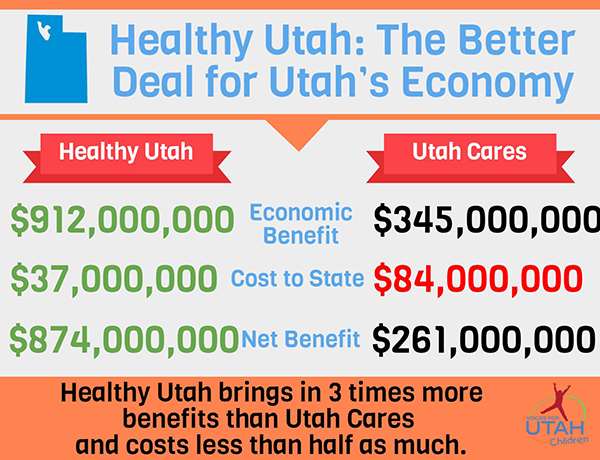
Take‐Aways:
Only Healthy Utah effectively closes the coverage gap. Thousands under Utah Cares will have access only to primary care, which covers only a small part of health care needs.
- Downside risks under Healthy Utah are borne by the federal government. Under Utah Cares, these risks are shared by the state and may result in significant cutbacks.
- “Woodwork” effects are the most significant long‐term risk faced by both programs, though they are not an unmanageable risk. Because of wider program appeal, woodwork effects are larger under Healthy Utah than Utah Cares.
- Healthy Utah functions predominantly through private insurance, which strengthens lowincome families, reduces financial burdens on health care providers and hospitals, and improves the state’s economy.
Research sponsored by Voices for Utah’s Children, AARP Utah and the Utah Health Policy Project
For more information, see the complete report:

